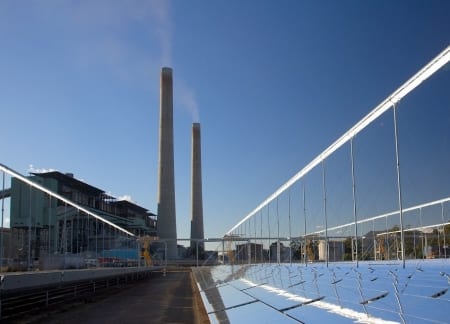Novatec Solar – a company majority owned by Australia’s Transfield Holdings – has commissioned a solar thermal energy demonstration plant in Spain that is based on a new type of molten salt storage technology.
The Germany-based Novatec Solar says the new plant uses a process called direct molten salt or DMS technology – where inorganic salts are used as a heat transfer fluid rather than oils.
 This means that the plant can operate at temperatures well above 500°C, resulting in a significant increase in power yield. This means that costs are lowered significantly and the solar plants can act as baseload generators if required.
This means that the plant can operate at temperatures well above 500°C, resulting in a significant increase in power yield. This means that costs are lowered significantly and the solar plants can act as baseload generators if required.
Andreas Wittke, CEO of Novatec Solar, which is 85 per cent owned by Australia’s Transfield Holdings, says this means that the technology will be able to operate on a “commercial” basis.
“The successful commissioning and the initial results of the DMS demo plant have confirmed our expectations of the technology,” he said in a statement.
“We are delighted that we can now offer solar thermal power plants with molten salt technology and thermal storage on a commercial basis.”
The use of DMS technology is being used at the 110MW Crescent Dunes power tower unit nearing completion in Nevada, which will be the largest solar thermal plant with storage in the world.
 Novatec Solar will use DMS with its linear Fresnel technology, which has been deployed as a demonstration “solar booster” at the Liddell coal generator in NSW (pictured), and is being mooted for a renewables-based replacement for the Collinsville coal fired power station in Queensland.
Novatec Solar will use DMS with its linear Fresnel technology, which has been deployed as a demonstration “solar booster” at the Liddell coal generator in NSW (pictured), and is being mooted for a renewables-based replacement for the Collinsville coal fired power station in Queensland.
Wittke says that the demonstration plant in southern Spain that features this new technology will be used to simulate a large number of different operating conditions to help develop the next generation of solar thermal power plants.
The storage capability means that the thermal energy can either be directly converted into electrical power or be stored in large molten salt tanks during periods of low demand.
This stored energy can be kept in reserve for times when production is low, for example when the sky is overcast. Solar thermal power plants with storage systems can supply electricity as and when required, which helps to ensure grid stability.
The molten salt technology was developed by BASF for the Fresnel collector technology, which uses flat glass reflectors rather than parabolic trough collectors.
The reflectors concentrate direct sunlight onto a receiver, through which the molten salt is pumped. This has the effect of heating the salt to temperatures in excess of 500°C.
“Our knowledge of salt chemistry and the new technology concepts are contributing to a significant improvement in the efficiency of solar thermal power plants,” says Kerstin Dünnwald, Head of Business Management for Inorganic Chemicals at BASF.
The DMS demonstration collector project is supported by the German Federal Ministry for Economic Affairs and Energy (BMWi) following a decision by the German parliament.








